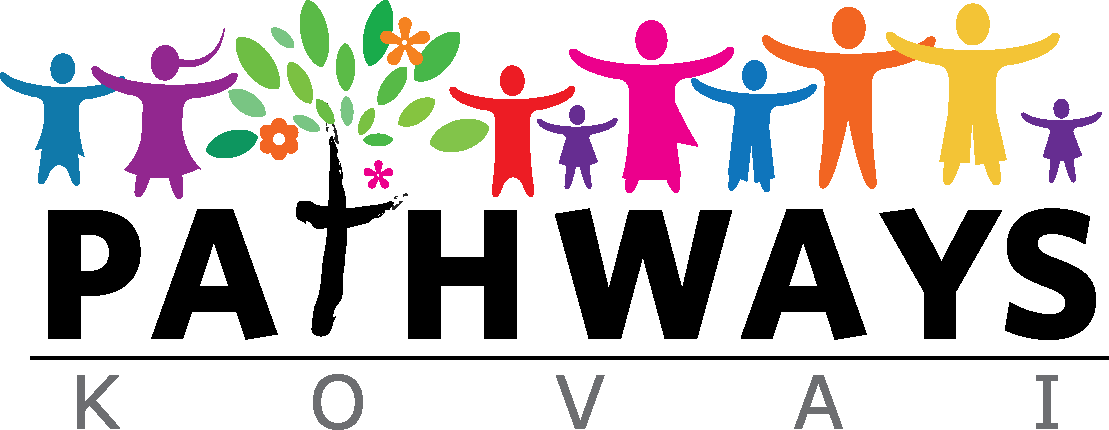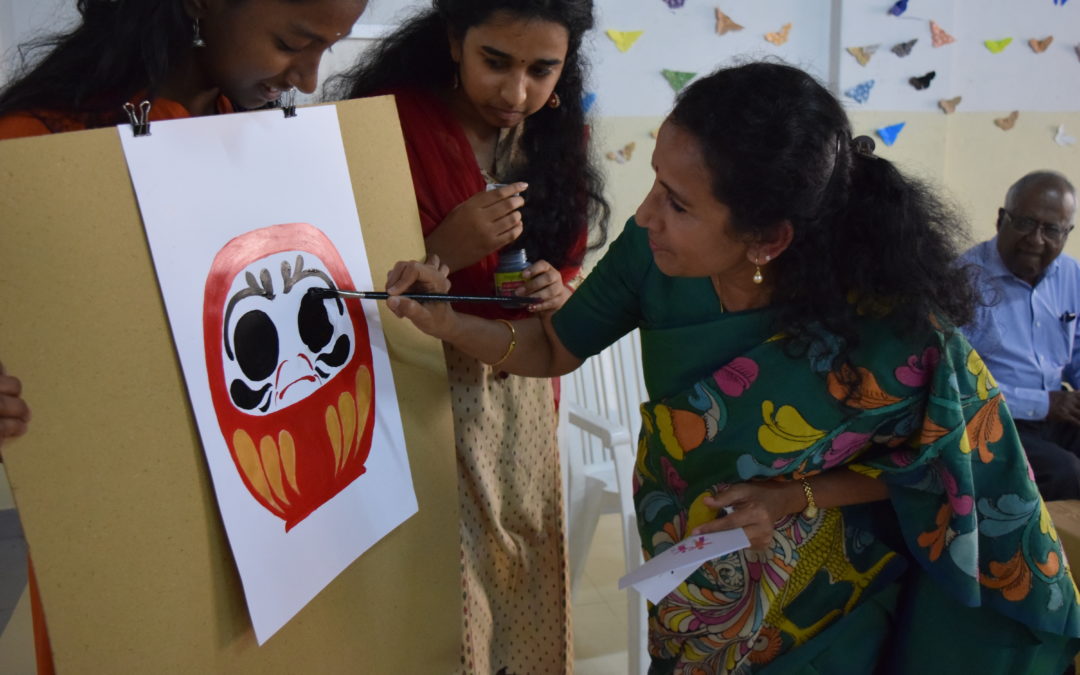| ‘Daruma’ the ultimate goal doll
Written by Dr Porpavai Kasiannan |
||
| I wrote this blog two years ago. this is a good time to update it as I wish to express my gratitude once again to a number of people who have helped me in the journey of establishing the educational aspect of Pathways. A lot has happened since the original post and the right time to reflect on the last two years is here. I took a yearlong break from my regular job from the end of August 2017. 2017 was dedicated to a number of things, the first and foremost was to consolidate the work I was doing in Coimbatore along with spending time with my family. The year started off a bit slow with the first couple of months spent on a lot of thinking around what would be best way to improve the child and adolescent mental health (CAMH) resources in Coimbatore. The only tangible thing that kept coming to my mind, was to train people on the ground in CAMH skills. Then, of course against suggestions that alluded to the challenges from various quarters and with no monetary resources and against my own best judgement, I decided to go ahead and try it. While this was brewing in my head and as I was having discussions with my long term supporters of my work in Coimbatore, I travelled with my 16 year old daughter to Japan in October 2017. That’s where this Daruma story begins. | ||
| The Japan trip was very meaningful in a number of ways. We had arranged the trip in such a way that we had a few days together with one of my best friends Dr Shakila and her two wonderful daughters, Ashwini and Niveditha. Ashwini had been working for a couple of years in Japan and was impressively fluent in Japanese. She introduced me to one of the main tourist souvenir icon the ‘Daruma’ doll. These were doll heads with no eyes and came is all sorts of sizes and colours. Ashwini described that it was very popular among Japanese and in most offices they would have these dolls as a way to motivate people to work towards their goals. Basically it works like this. When you embark on a new project or when you are working towards a goal, you acquire a Daruma doll and paint one eye and leave in a prominent spot where you can see it every day. Once you complete the project you paint the other eye in. | ||
| Information from Wikipedia: Daruma is a hollow, round, Japanese traditional doll modelled after Bodhidharma, the founder of the Zen tradition of Buddhism. These dolls, though typically red and depicting a bearded man (Dharma), vary greatly in color and design depending on region and artist. Though considered a toy by some, Daruma has a design that is rich in symbolism and is regarded more as a talisman of good luck to the Japanese. Daruma dolls are seen as a symbol of perseverance and good luck, making them a popular gift of encouragement. The doll has also been commercialized by many Buddhist temples to use alongside the setting of goals. | ||
| Anyhow, by the end of the Japan trip I had decided that we would start a course in CAMH by the end of the year and I had already started doing some work towards it. Although, I do not believe in good luck or mythology, the concept of ‘perseverance’ as the meaning of a Daruma doll was very appealing, along with a visual reminder of the work ahead and of progress and completion at the end. Lo and behold I bought a smallish red Daruma on October 10, the last day of our stay in Japan. I had in mind to paint one eye as soon as the course started, but had been too distracted with the actual work, the red Daruma sat on top of the cupboard without an eye. | ||
| The post graduate certificate in child and adolescent mental health (PG CAMH course) has been a success thanks to a number of people and factors. This blog post is my way of acknowledging and appreciating all the support. When the course was advertised I had many restless nights wondering if we would be able to recruit the minimum 10 students for the course. We needed at least ten students for the course to be viable. The response initially was lukewarm after spreading the message via social media. The start date for the course was set at December 16, 2017. There were a number of factors that were not in favour such as university affliation, lack of accreditation etc. Despite that we started getting more interest and ended up with 24 students, the 24th student fronting up on the day of the course. The students were from various backgrounds, the majority are paediatricians, a few psychiatrists, one general practitioner, a paediatric dentist, a catholic priest and social worker who work in a facility for street children, counsellors and psychologists. The course became financially self-sufficient as we were able to use the funds to procure the necessary audio-visual and office equipment. | ||
| This project would not have been possible without the support of a lot of people. When we started Dr Selvaraj (Vazhikatti) and Dr Vinu Aram (Shanti Ashram and ICPH) provided valuable feedback and support and agreed to be our clinical partners. Dr Selvaraj provided us with a hall that would accommodate twenty five to thirty students. A special thanks to Sophie Gaur, who designed this beautiful website, our Pathways Logo and also the CAMH course brochure all out of goodwill. With basic infrastructure we started the course. We moved to our own premises early last year and have now successfully completed two batches with a total of thirty two graduates and the third cohort is underway with twenty students. | ||
|
|
I wish to thank all the teachers who have come on board to teach from India, Australia, UK and Canada. I have to name them all otherwise this exercise is incomplete. The wonderful teachers are Dr Manohari S M, Dr Sowmya Bhaskaran, Dr Tejas Golhar, Dr Prakash Chidamabaram, Dr Vibhay Raykar, Dr Meenakshi Sundaram, Dr Selvaraj, Dr Sowmya Basu, Dr Seetha Goplakrishna, Dr Seema Padencheri, Dr Sangeetha Karunagaran, Dr Vikram Palanisamy, Dr Rani Samuel and Dr Suhas Chandran. We started with ten teachers and we have sixteen teachers now along with Dr Natasha Saldhana who has joined recently The hope is for more teachers to come on board so that we have a sustainable pool to support one another. All of them have been extremely generous in sharing their knowledge and experience for the greater good. Lastly the thanks and congratulations go to all the enthusiastic students who actually have made this journey a rewarding one. My daughter and niece painted a Daruma figure with one eye and we completed the second eye on the 2018 graduation ceremony. It currently adorns our office in RS Puram. | |
| Some final thoughts about the concept of Daruma as researched from the very scientific Internet resources. Daruma dolls are constant reminders of what the Japanese call the “ganbaru” spirit. The word Ganbaru is often translated to mean “doing one’s best”, but in practice, it means doing more than one’s best. The word emphasizes “working with perseverance” or “toughing it out. “Ganbaru means “to commit oneself fully to a task and to bring that task to an end.” It can be translated to mean persistence, tenacity, doggedness and hard work. The term has a unique importance in Japanese culture. Life is full of pitfalls and bumps on the road. It’s inevitable that you’ll stumble sometimes. But it’s up to you to get back up. It’s in your own power and will to keep moving.
The Daruma doll embodies the popular Japanese proverb: “Fall down seven times, stand up eight.” That’s why Daruma dolls have such determined expressions. They never give up. They are built to automatically bounce back when knocked over. They are a metaphor of grit and endurance. I don’t know how much of this I actually buy into. But the red Daruma has been a companion from the beginning of this journey and will hopefully serve as a reminder for the rest. |
+91 9150689885
pathwaysfoundationkovai@gmail.com


Recent Comments